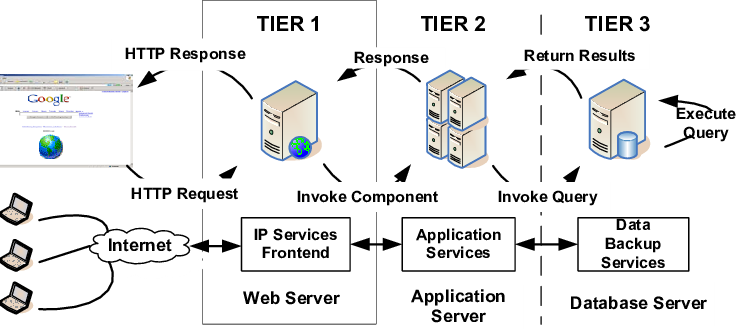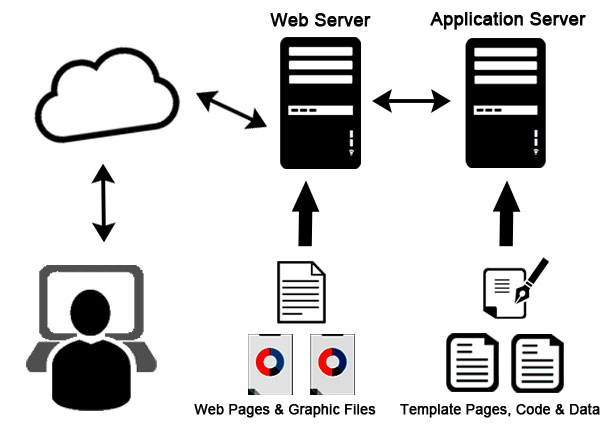
Introduction to Application Server
Application Server is a type of server designed to install, operate, and host applications. In the early days of application servers, there was a huge growth in the number of applications brought to the Internet. Those applications became bigger and bigger with the demand for adding more and more functionalities to the application and become more complex to run and maintain. There was a need for some kind of program on the network while it will share application capabilities in an efficient and organized manner.
What is an Application Server?
An application server is a program that resides on the server-side, and it’s a server programmer providing business logic behind any application. This server can be a part of the network or the distributed network.
Now, if we would like to know the purpose of a server program, it goes this way:
Ideally, server programs are used to provide their services to the client program that either resides on the same machine or lies on a network.
Working
They are basically used in a web-based application that has 3 tier architecture. The position at which the application server fits in is described below:
- Tier 1 – This is a GUI interface that resides at the client end and is usually a thin client (e.g. browser)
- Tier 2 – This is called the middle tier, which consists of the Application Server.
- Tier 3 – This is the 3rd tier which is backend servers. E.g., a Database Server.
Source: https://images.app.goo.gl/icJBVqjMJYHMpvBb9
As we can see, they usually communicate with the webserver for serving any request that is coming from clients.
The client first makes a request, which goes to the webserver. The web server then sends it to the middle tier, i.e. the application server, which further gets the information from 3rd tier (e.g. database server) and sends it back to the webserver. The web server further sends back the required information to the client. Different approaches are being utilized to process requests through the web servers, and some of them are approaches like JSP (Java server pages), CGI, ASP (Active Server Pages), Java Scripts, Java servlets, etc.
Use of Application Servers
It helps the clients to process any requests by connecting to the Database and returning the information back to web servers.
The main purpose of the application server is given below:
- A mechanism for reducing the size and complexity of the client programs.
- For the need to cache and control the data flow for better performance.
- A mechanism for implementing security for data as well as end-user traffic.
Although they can have a different purpose, not all application servers are used for the same functionalities set. For example, someone might need it for scalability; others might need it for better managing applications for the web, etc.
Advantages
- Provides a mechanism for dealing with all the components and running services like session management, synchronous and asynchronous client notifications.
- It becomes very easy to install applications in one place.
- Changing to any configuration, such as moving the Database server, can be done centrally from one location.
- Patches and security updates are easy to deploy through them.
- It enables the ability to distribute requests to different servers based on their availability. This is done via Load Balancing.
- It provides security to applications.
- It enables fault tolerance with the ability to recover/failover recovery.
- It saves big time if we are required to install a copy of configurations on each machine individually.
- It supports transaction support.
- When it comes to performance, the application server greatly improves application performance as it is based on the client-server model.
Examples
There is a huge number of application servers that are used today. Some of the examples are given below:
- JBoss
- Weblogic
- Websphere
- Glassfish
- Tcat Server
- Apache Geronimo
- JRun
- Oracle OC4J
- Sun GlassFish Enterprise Server
- SAP Netweaver AS
- Sybase Enterprise Application Server
Types of Application Server
Application servers can be of 3 categories:
- Active Application Server – This server is used to provide support and a rich environment for business logic that is involved on the server-side, which is expressed in the form of rules, components, and objects. These types of servers are also called stateful server.
- Web Information Server – This type of server is used for generating pages from the database by employing HTML templates. These types of servers are also known as stateless servers.
- Component Server – This software plays a primary role in providing database access to software components such as COBRA, DLL, and Java Bean. It also provides support to transaction processing requests.
Choosing the Right One
In order to choose the right one for your applications, you can start with identifying and prioritizing the requirements if the particular environment.
A few of the factors could be:
- Performance
- Administration
- Development
- Support
- Compliance
- Scalability
- Reliability
- Cost
Once you are done with the above task, you can start looking for an application server that best meets your demands. For e.g., if you are having a large customer base, the application performance should be of topmost priority. And if your company is small, the cost might be a factor as well. Scalability and administration are also one of the major factors to look into if your application is growing each day.
Conclusion
As part of this post, we have learned about the application server’s overview, their working and usage, advantages of having and choosing the right one. At the end of this article, the audience should be able to select the application server better that might suit their environment.
Recommended Articles
This has been a guide to What is Application Server. Here we discuss the Advantages, Applications, and Types of Application Server. You can also go through our other suggested articles to learn more –


